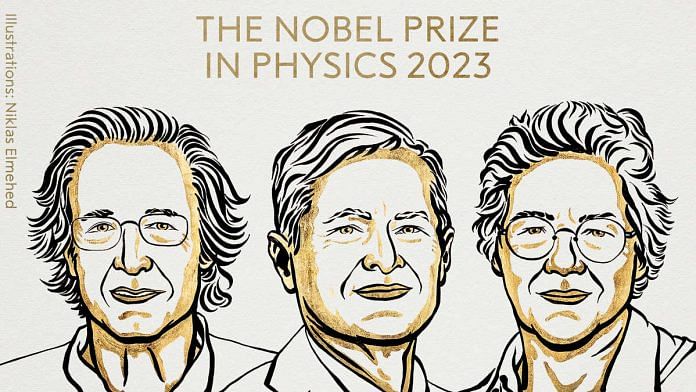Bengaluru: The Nobel Prize in Physics has been awarded this year to three scientists for their remarkable work on creating ultra-short bursts of light to peer into the hidden realm of atoms, molecules, and electrons.
Pierre Agostini (Ohio State University, USA), Ferenc Krausz (Max Planck Institute of Quantum Optics, Germany), and Anne L’Huillier (Lund University, Sweden) share the 11 million Swedish krona (about US$1 million) prize money. It is the 117th Nobel Prize in Physics. Notably, L’Huillier is only the fifth woman among the 224 Nobel laureates in this field; the previous four all shared their prize with three others each.
The three had worked independently on similar phenomena at different times in their careers, with their combined contributions enabling the creation of rapid pulses of light that are measured in attoseconds, or 1×10−18 of a second. For context, an attosecond is to a second what a second is to about 31.71 billion years.
These flashes of light enable the capture of very rapid processes at a sub-atomic level, which would have otherwise not been visible to human eyes through other existing technologies.
The three scientists’ work has “given humanity new tools for exploring the world of electrons inside atoms and molecules,” according to the Royal Swedish Academy of Sciences, which awards the prize.
In particular, it added, the attosecond pulses can be used to measure the rapid processes in which electrons move or change energy.
The new field of experimental physics where such observations take place is referred to as ‘attosecond physics’. It has a variety of potential applications, such as the study of electron behaviour in materials or the identification of molecules in medical applications.
ThePrint explains the science and developments in the story of attosecond physics, as well as the work that led to the Nobel for the three scientists.
Also Read: How Ian Wilmut’s work on Dolly the sheep shaped cloning & stem cell research
How the breakthrough came about
Human sight and perception miss a lot of rapidly occurring processes. For instance, a series of rapid movements like the flapping of a hummingbird’s wings (80 times a second) turns into a blur. Consecutive short events blur together even more and it is impossible for humans to observe and distinguish between them.
But the ability to observe fast-moving events has advanced rapidly in the past century.
High-speed photography, for example, now allows the capture of events in microseconds, or one millionth of a second.
In the case of a hummingbird flapping its wings, a camera with a shutter speed that is faster than a single wing flap can capture and allow us to see individual movements.
At atomic scales, processes occur even more rapidly.
Atoms in molecules move in femtoseconds, or millionths of a billionth of a second. Sub-atomic particles like electrons move in even shorter attoseconds.
Since the 1980s, femtoseconds were thought to be the lowest limit that flashes of light could be produced.
Since laser light is made up of various wavelengths, it was believed that the time taken to create the crest and trough of a wavelength of the shortest possible burst of light was in femtoseconds.
But, in a span of decades, the work of the three Nobel-winning scientists has opened up the field of attosecond physics.
They developed a method to create new wavelengths to add to light pulses by using the interaction of light with gas.
These interactions produced overtones of light, just like musical instruments produce overtones of sound.
Overtones are resonant frequencies above the main frequency of the sound produced— this is what causes the same note played on various instruments to sound different.
When lasers interact with gas, escaping electrons generate light overtones.
This happens when an electron absorbs energy from the laser and becomes excited, escaping from its atom.
When the laser field has passed, this free electron is pulled back into the atom, but it holds excess energy that needs to be discarded. This energy is then emitted as flashes of UV light in higher frequencies that resonate with the original frequency of the laser, producing overtones.
These overtones interact with each other, and produce more intense waves, which are a series of short laser pulses measured in attoseconds.
History of the winners’ work
At the press conference for the Nobel ceremony, Anne L’Huillier said she had been teaching when she received the call about her win and that it had been difficult to get through the class afterwards.
Her groundbreaking work started more than 30 years ago. In 1987, she discovered how light overtones are created by passing infrared laser light through a noble gas.
A decade and half later, in 2001, Pierre Agostini produced the first series of light pulses measured in attoseconds, with each pulse lasting just 250 attoseconds.
Simultaneously, Ferenc Krausz had been working on another experiment, which made it possible to isolate a single pulse from such a laser, and succeeded in isolating or using for observation a single pulse that lasted 650 attoseconds.
(Edited by Asavari Singh)
Also Read: WHO recommends 2nd malaria vaccine — why Oxford-SII shot is likely to cost less, have wider reach



